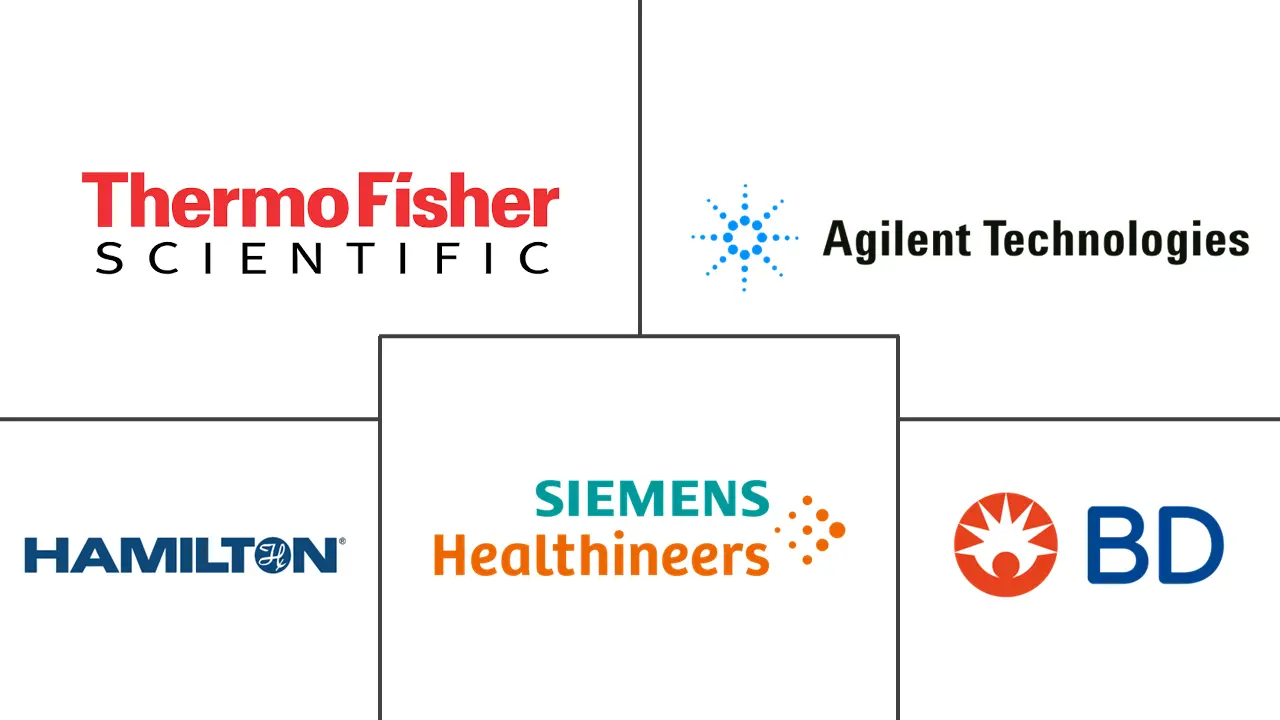Lab Automation in Bioanalysis Market Size and Share
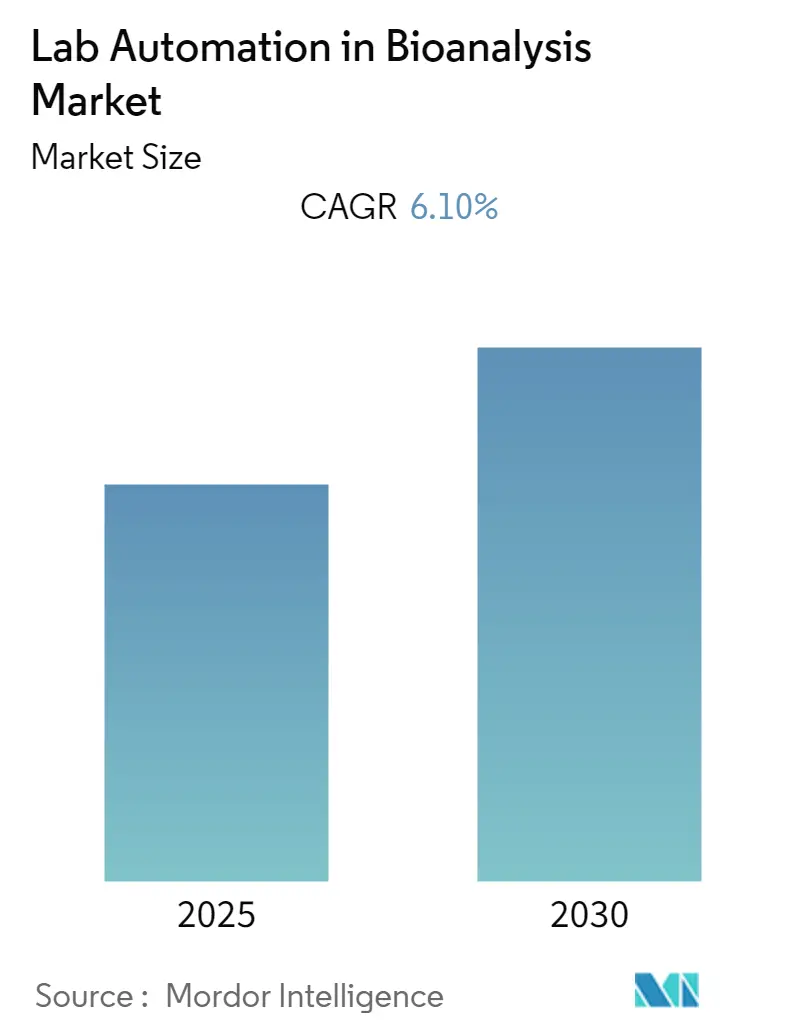
Lab Automation in Bioanalysis Market Analysis by Mordor Intelligence
The Lab Automation in Bioanalysis Market is expected to register a CAGR of 6.1% during the forecast period.
- Laboratory automation transformed the realm of drug discovery over the years, primarily through two major influential factors, such as error reduction and cost-benefit. Additionally, automation transformed the traditional drug discovery process by making it feasible to identify many targets through the biotechnology revolution and numerous combinatorial technologies, which fueled compound collection.
- Vendors present in the market ecosystem focus on organic & inorganic growth strategies to stay competitive in the market. For example, Agilent Technologies has developed Seahorse XF HS Mini Analyzer, the newest addition to the Seahorse XF platform that delivers the best in Seahorse XF data quality, workflow, and user experience. Cell metabolism is a major driver of cell fate, function, and fitness.
- Moreover, according to ClinalTrials.gov, the total number of registered clinical studies as of March 2022 was 409,300. Such increased focus on research and development is expected to drive the need for enhancing laboratory capabilities across the world.
- With the outbreak of COVID-19, the lab automation in bioanalysis market will witness a significant increase in demand due to the increasing requirement for testing, tracing, and tracking of the virus and the fact that the diagnostic lab needs many capabilities to test up to thousands of samples per day is driving the lab automation in the market studied.
Global Lab Automation in Bioanalysis Market Trends and Insights
Hematology Analyzers Segment to Grow at a Significant Rate
- An automated analyzer, with minimal human assistance, measures various chemicals and other characteristics in several biological samples, both efficiently and quickly. The use of automated analyzers is more convenient, as compared to the manual analysis of chemical reactions. It uses control systems and different programs to analyze chemical reactions. Furthermore, it saves time due to the automation technique.
- Hematology analyzers include multiple analytical modules with unique sample preparation processes. They are used in the diagnosis of various diseases, such as infections, anemia, viruses, diabetes, genetic problems, and cancer. Moreover, they regulate the plasma drug level for both therapeutic and illicit drugs.
- Many of the market vendors are strategically investing in research and development and are introducing new products in the market. For instance, in March 2022, Mindray launched BC-700 Series, a hematology analyzer series that incorporates both the erythrocyte sedimentation rate (ESR) tests and Complete Blood Count (CBC). In addition, the series includes two autoloader models, such as the BC-760/BC-780, and two open vial models, such as the BC-700/BC-720, that are designed to empower medium-volume laboratories with advanced technologies.
- Similarly, in April 2022, Sysmex Europe launched the Flow Cytrometer XF-1600 with CE marking (indicating compliance with European IVD Regulation and IVD use). The product is a 10-color analyzer designed for highly efficient and reliable data collection in immunophenotyping. Thus, the launch of new products is driving more sales opportunities for the vendor.
- Further, the automated hematology analyzer helps diagnose malaria by conducting qualitative analyses of formed elements in whole blood. The analysis is based on counting DNA-containing, malaria-infected red blood cells that have malaria parasites. In July 2020, despite the impact of COVID-19, Sysmex received marketing approval in Japan for its Automated Hematology Analyzer XN-31, making it available for the in-vitro diagnosis of malaria in the country.
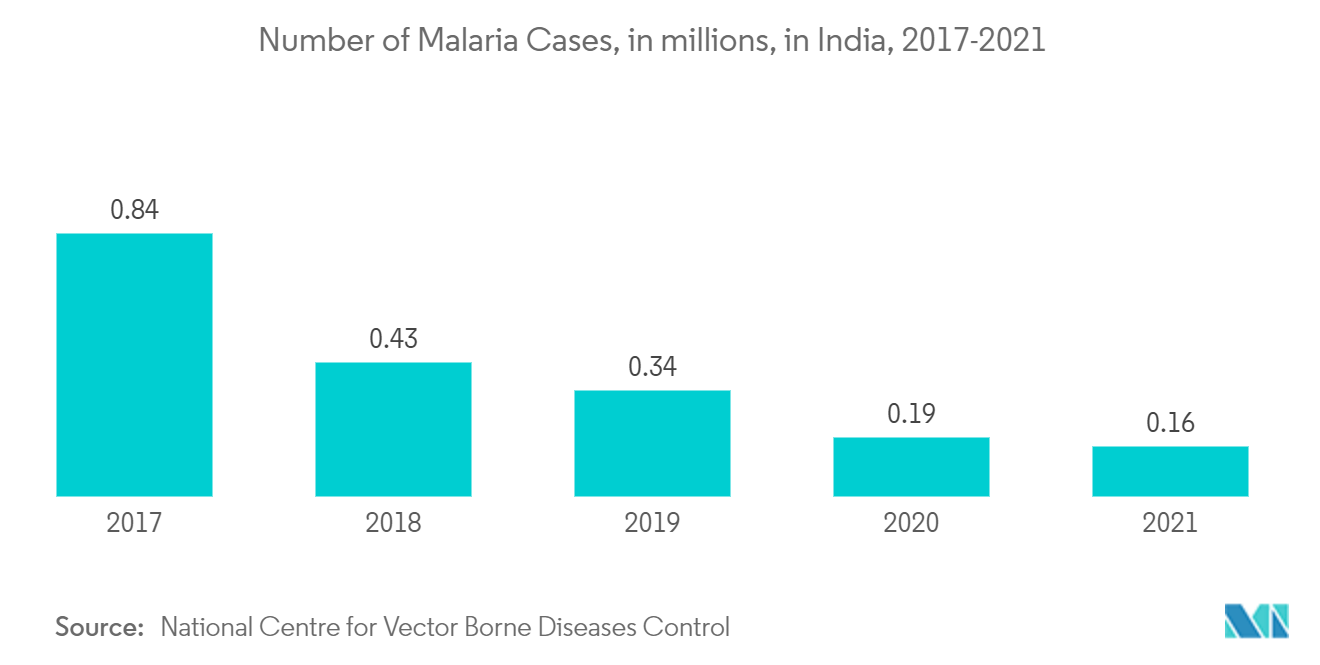
North America to Hold Largest Market Share
- A rise in the number of clinical and pre-clinical studies in the region has made the need for speedy analysis of samples imperative, making automation one of the key components contributing to the growth of the market. For instance, as per the World Health Organization, the United States had the highest total number of trials registered during 1999-2021 (157,618), followed by China and Japan.
- Strict regulations by the US government and the FDA, the growing demand in the diagnostic market, and the increasing usage of discovery and research labs, owing to the rising presence of various diseases, such as cardiovascular diseases and neurological diseases in the region, have fueled the growth of the market. The US dominates the North American market and is the major revenue contributor in the region.
- The United States has been a pioneer in clinical research for years. This country is home to some of the major pharmaceutical companies, like Pfizer, Novartis, GlaxoSmithKline, J&J, and Novartis. The country also has the highest concentration of contract research organizations (CROs). Some of the major CROs in the country are Laboratory Corp. of America Holdings, IQVIA, Syneos Health, and Parexel International Corp.
- Further, many major vendors continue to invest in expanding their footprint across the region, which is aiding the market growth. For instance, in September 2021, Thermo Fisher Scientific Inc. announced plans to invest USD 154 million and create 290 additional jobs with an expansion of its Pitt County, NC operations.
- Product innovation also continues to rise in the region. For instance, in October 2021, Sysmex America introduced the XN-30 Research Use Only (RUO) Automated Hematology Analyzer, the first automated hematology analyzer for malaria detection.
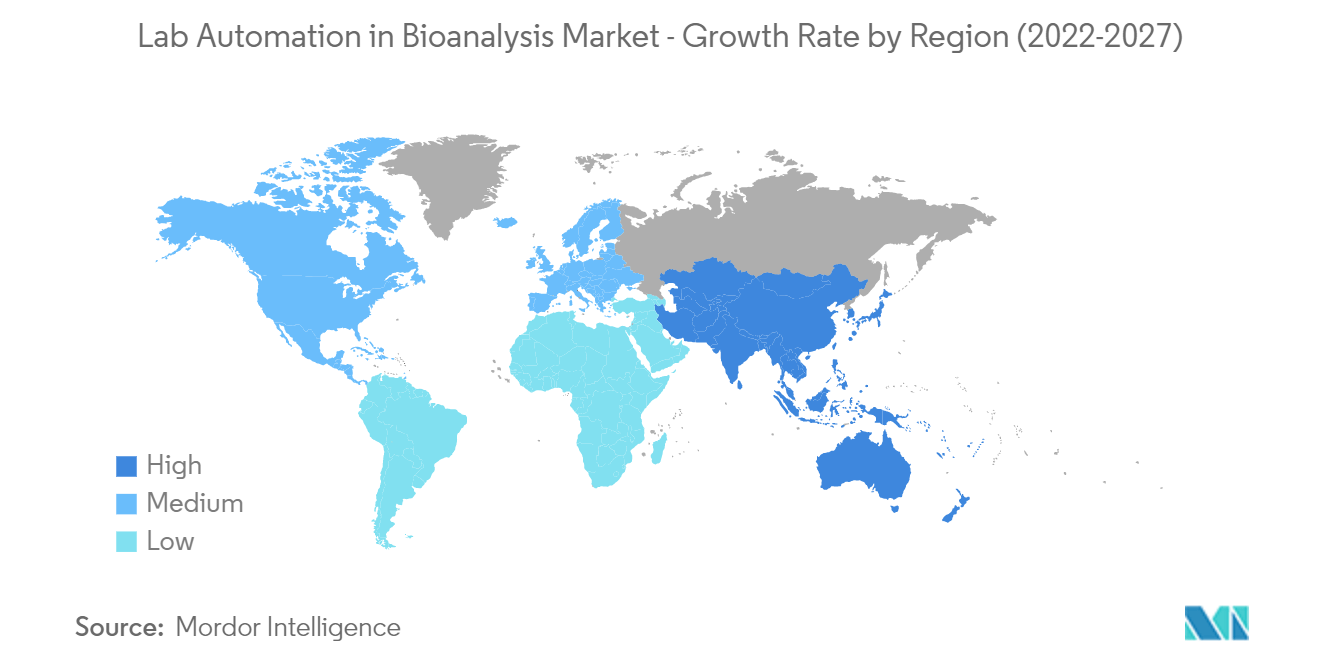
Competitive Landscape
The lab automation in bioanalysis market is consolidated. Major players have the maximum market share. Also, the players in the lab automation in bioanalysis market are increasingly competing against each other based on factors such as product innovations and technological advances.
- May 2022 - Thermo Fisher Scientific introduced the Automated Indiko Clinical Chemistry analyzer, which produces results quickly with sample-oriented testing. It can operate with low sample volumes and uses small amounts of water which enables running the laboratory more cost-efficiently.
- February 2021 - Beckman Coulter announced the launch of the DxH 560 AL, a tabletop hematology analyzer designed to reduce the time and resource constraints faced by small- to mid-sized laboratories. With its auto-loading functionality, closed tube aspiration, and walk away capabilities, users can continually add up to 50 samples, provide safety against blood-borne pathogens and spend less time on manual instrument tasks.
Lab Automation in Bioanalysis Industry Leaders
-
Thermo Fisher Scientific
-
Agilent Technologies
-
Hamilton Company
-
Siemens Healthineers AG
-
Becton Dickinson & Co.
- *Disclaimer: Major Players sorted in no particular order
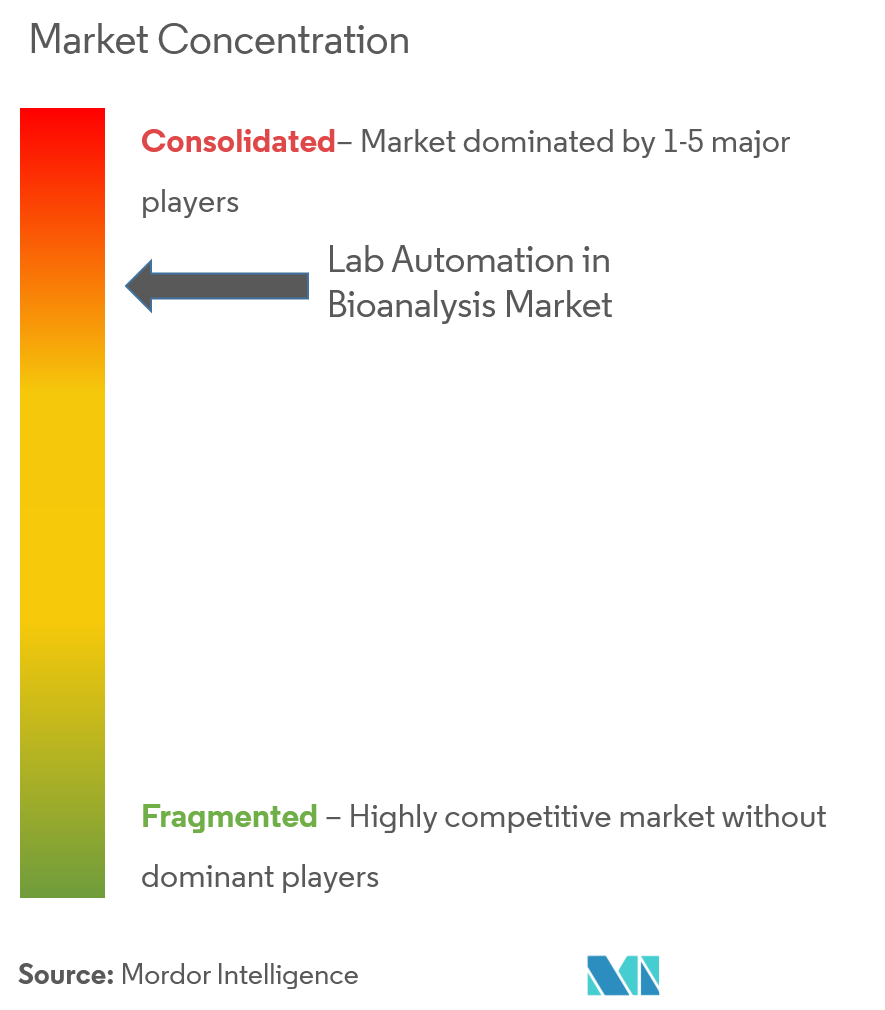
Recent Industry Developments
- February 2022 - As part of a mutual objective to safeguard high and consistent liquid handler performance levels, Hamilton Company and Artel announced that they were near the completion of a packaged solution to standardize the performance validation of Hamilton's automated liquid handlers.
- January 2022 - Agilent Technologies Inc. announced the release of the Agilent Seahorse XF Pro Analyzer, featuring new pharma-oriented workflow solutions incorporating advanced experimental design and analysis tools. The analyzer is expected to enhance critical aspects of live-cell analysis, particularly for researchers working in immunotherapy, early drug discovery, and preclinical safety assessment.
Global Lab Automation in Bioanalysis Market Report Scope
Lab automation in bioanalysis involves the use of dedicated workstations and software to program instruments to automate routine laboratory procedures. The extent of automation required is dependent on the nature of the task to be performed, the need for processing, and the amount of human intervention. The Lab Automation in Bioanalysis Market is Segmented by Offering (Equipment, Software), Type of Analyzers (Biochemistry Analyzers, Immuno-Based Analyzers, Hematology Analyzers, Cell Counters, Coagulometers), and Geography.
| Equipment | Automated Liquid Handlers |
| Automated Plate Handlers | |
| Robotic Arms | |
| AS/RS | |
| Vision Systems | |
| Software |
| Biochemistry Analyzers |
| Immuno-Based Analyzers |
| Hematology Analyzers |
| Cell Counters |
| Coagulometers |
| North America |
| Europe |
| Asia-Pacific |
| Latin America |
| Middle East and Africa |
| By Offering | Equipment | Automated Liquid Handlers |
| Automated Plate Handlers | ||
| Robotic Arms | ||
| AS/RS | ||
| Vision Systems | ||
| Software | ||
| By Type of Analyzers | Biochemistry Analyzers | |
| Immuno-Based Analyzers | ||
| Hematology Analyzers | ||
| Cell Counters | ||
| Coagulometers | ||
| By Geography | North America | |
| Europe | ||
| Asia-Pacific | ||
| Latin America | ||
| Middle East and Africa |
Key Questions Answered in the Report
What is the current Lab Automation in Bioanalysis Market size?
The Lab Automation in Bioanalysis Market is projected to register a CAGR of 6.1% during the forecast period (2025-2030)
Who are the key players in Lab Automation in Bioanalysis Market?
Thermo Fisher Scientific, Agilent Technologies, Hamilton Company, Siemens Healthineers AG and Becton Dickinson & Co. are the major companies operating in the Lab Automation in Bioanalysis Market.
Which is the fastest growing region in Lab Automation in Bioanalysis Market?
Asia-Pacific is estimated to grow at the highest CAGR over the forecast period (2025-2030).
Which region has the biggest share in Lab Automation in Bioanalysis Market?
In 2025, the North America accounts for the largest market share in Lab Automation in Bioanalysis Market.
What years does this Lab Automation in Bioanalysis Market cover?
The report covers the Lab Automation in Bioanalysis Market historical market size for years: 2019, 2020, 2021, 2022, 2023 and 2024. The report also forecasts the Lab Automation in Bioanalysis Market size for years: 2025, 2026, 2027, 2028, 2029 and 2030.
Page last updated on:
Lab Automation in Bioanalysis Market Report
Statistics for the 2025 Lab Automation in Bioanalysis market share, size and revenue growth rate, created by Mordor Intelligence™ Industry Reports. Lab Automation in Bioanalysis analysis includes a market forecast outlook for 2025 to 2030 and historical overview. Get a sample of this industry analysis as a free report PDF download.
